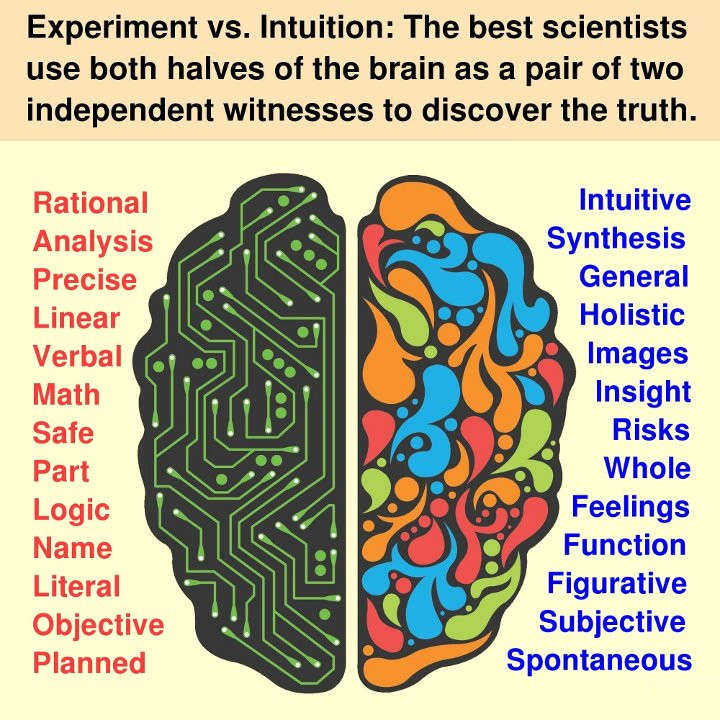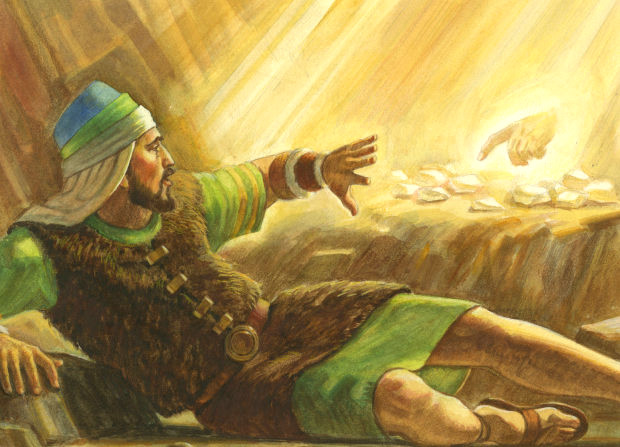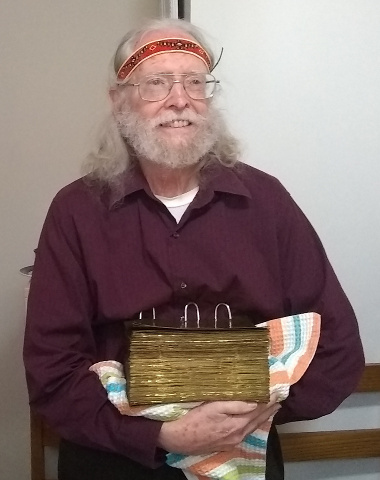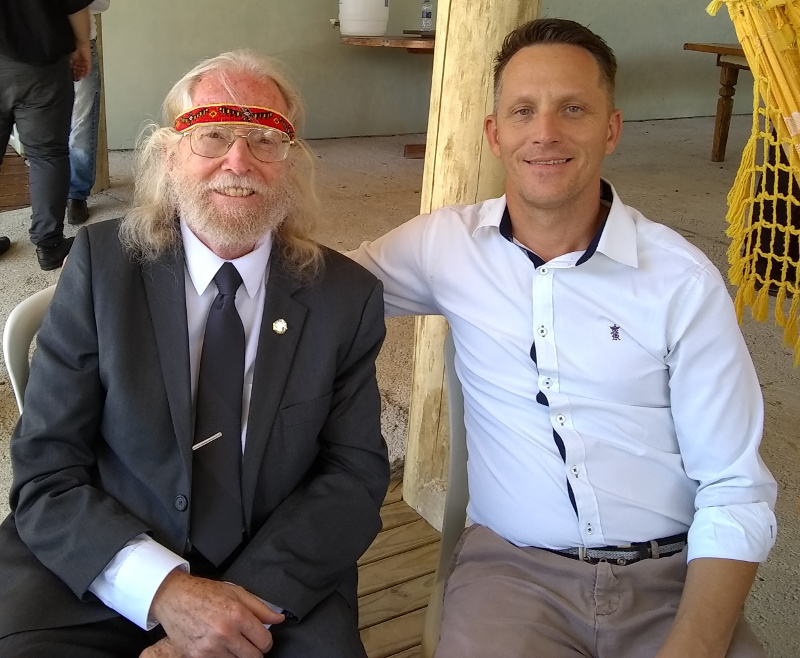
by John P. Pratt
19 Sep 2020, Trumpets (PH), Equinox (E), New Year (S)
©2020 by John P. Pratt. All rights Reserved.
|
1. What is Reasonable? 2. Miracles 3. Apparent Contradictions 4. The Sealed Book 4.1 Why Not LDS Prophet? 4.2 Why Brazil? 4.3 Why Imperfect English? 5. Conclusion Notes |
Recently in a political discussion, someone was accused of being "beyond reason". Of course, the intended meaning of those words is to describe someone who is out of touch with the "real world" and perhaps even ready for an insane asylum. But some people in such institutions are there because they can perceive truth or see the invisible spirit world and made the mistake of telling others about it. If so, then "beyond reason" could have a second meaning of being "more advanced than being limited to only using reason by also using the faculties of intuition or direct perception of truth".
 |
The word "reasonable" implies that the concept being discussed can be deduced from a line of logical reasoning. All such deductions in logic are based on premises which most people agree are self-evident from the natural observable world. Courses in logic, which have long been removed from our public schools, point out that deductions are only as good that the initial premises. For example, (1) All dogs bark, (2) Rover is a dog, therefore it can be deduced that (3) Rover barks. But if it is not true that all dogs bark, then the reasonable deduction may be false. If Rover is a Basenji, the so-called "barkless dog", then Rover probably does not bark.
 |
Our brains have two halves, with each half apparently dedicated to processing different views of the world we live in. Researchers report that the left half processes input in a linear fashion, the same as is used in logical reasoning, where one fact builds on another to reach a conclusion. The right half, on the other hand, processes incoming signals more as pictures and spatial relationships, which often show many relationships simultaneously.
 |
In my youth, Dick Tracy in the newspaper comic strip wore a two-way wrist radio that was within his wrist watch. That was before the days of television. Surely some readers rejected that idea as "unreasonable", but few today would think so. What is a miracle to some and commonplace to others is based largely on what those people are already familiar with. Many people in Europe did not believe in the existence of animals of Africa which they had never seen, and even now we wonder if unusual animals we see on the Internet were created by manipulating photos of other animals or by having been created with computer graphics.
 |
This unbelief appears to be based largely on the lack of belief in an omnipotent God who created the earth and all life therein, combined with their conceit that their knowledge of nature, based on their own very limited experience, is rather complete. That is, many are skeptical of anything not fitting into their world view. One ironic point is that many Christians, who claim to believe in God, still do not believe in many of the Biblical miracles. Many do not believe there was a worldwide Deluge, nor that Adam and Eve were real people who lived nearly a thousand years. That is even in spite of evidence from science that all people descended from one woman and that human cells can be kept alive indefinitely.
One classic example of a major miracle being rejected as unreasonable comes from the Book of Mormon. Samuel the Lamanite had prophesied that on the Savior's birth, the night would not be dark, even though the sun would set as usual. That prophecy was so highly ridiculed that believers were to be put to death if it did not happen with the time prophesied. After the execution date was set, the sign was given, and just about everyone believed! But then, not long afterward, many refused to believe the sign because it was "not reasonable that such as being as Christ shall come" (Hel. 16:17-19). Thus, reason was effectively used to discredit one of the most impressive signs and prophetic fulfillments in history, which virtually everyone observed. Indeed, none of the best prophecies are "reasonable", but instead seem impossible to fulfull!
The Lord sometimes gives apparently contradicting prophecies, perhaps to test the faith of his people or to get them to solve a puzzle. After all, "It is the glory of God to conceal a thing: but the honor of kings is to search out a matter" (Prov. 25:2).
 |
Another example, involving an actual king, was where Jeremiah prophesied that King Zedekiah of Judah would see King Nebuchadnezzar of Babylon, who would take him captive there (Jer. 32:4-5), and yet Ezekiel prophesied that Zedekiah would never see Babylon (Ezek. 12:13). The king chose not to believe such apparent contradictions, but later had plenty of time to accept both, when he was blinded after he saw Nebuchadnezzar and then taken captive to Babylon where he died.
Another current example is that the Book of Mormon states that the sealed portion contains the vision of the brother of Jared which will be revealed by the Savior himself when he comes (2 Nephi 27:10, Ether 4:4-7), and yet there are recent claims that part of the sealed Plates of Mormon has been translated and published, yet that book does not contain that vision. Does that mean the new book must be a fraud? See if you can solve that puzzle by carefully examining the wording, before looking at this endnote.[4]
 |
Last year on 26 Mar 2019 a new book was published claiming to be the translation of the first few plates of the sealed part of the Plates of Mormon, from which the Book of Mormon had been translated by the Prophet Joseph Smith. There had been fraudulent claims of such a book made before, so how could one know if this book were indeed truly what it claimed to be?
Many who read it used reason to decide its authenticity, rather than praying and asking God if it were true. Some felt that it was so obviously bogus that it was not worth troubling Him about. Let us consider some of the logical arguments against the book. One was considered in the last section, namely that the sealed portion is supposed to contain the vision of the brother of Jared, and this book does not.
Many complaints were raised about the actual content of the book, such a having material similar to the Book of Enoch and not having enough new material in it. Those issues were discussed in my initial book review,[5] so they are not again mentioned here. Let us instead discuss some reasons to reject the book because of the manner of translation.
The most common reason for dismissing the book without an examination was the assumption that the translation would have to come from the LDS Church through the official channels. That argument is not even based on any statements from LDS leaders known to me, that is, the claim that when the sealed portion is revealed, it would have to come from Church leaders. These same people have no problem with the Dea Sea Scrolls having been translated by scholars.
Actually, when the new seer was called by the Angel Moroni to do the translation, he was in fact a member of the LDS Church. He was subsequently excommunicated for not renouncing the work, so that by the time the book was published he was no longer affiliated with the Church.
This complaint does not really need a response because it is founded on an unwarranted assumption. It is included only because it is the most common complaint. The majority of LDS members appear to be waiting to be told everything they need to do to prepare for the Millennium, and nothing has been forthcoming even though we are well into the beginning period of this thousand years.
My last article summarized several areas in which the LDS Church has changed several key doctrines, such as the definition of tithing, as well as sacred ordinances, such as the sacrament. Perhaps it is because of these changes that the translation did not come through official Church channels. In any case, for whatever reason, the Lord chose to have just a regular member of the Church translate it.
 |
Such reasoning is reminiscent of Nathaniel's question, after being told that the Messiah had been found, "Can there any good thing come out of Nazareth?" (John 1:46). He went to see for himself and accepted the fact that Jesus of Nazareth was indeed the Messiah, in spite of the prophecy that he would be born in Bethlehem. That is another apparent contradiction which people had to overcome to accept Jesus, and a similar one exists to accept Mauricio as a true seer, called of God.
Another complaint that has been raised is based on comparing this new English translation to the language of the Book of Mormon. Mauricio, like all Brazilians, speaks Portuguese. He does not speak English, which was clear when I met him. Yet, he translated the plates into both Portuguese and English, using the interpreter stones which the Angel Moroni gave him. That was a miracle in itself!
 |
In Mauricio's translation, on the other hand, such is not the case. He explains that as he looked at each character, he saw several possible translations, and he picked one that seemed right. Thus, the actual phrase "And it came to pass" is rarely seen in the book, but instead other language of "It happened then", "It occurred after this", "And it happened", "It so happened", "It was then", "But it came to pass", and even "Happened then" are found.[7]
To me this translation is refreshing and not boring, but to others, because it is different from the translation done by Joseph, it is unacceptable. Moreover, to me the new translation is actually superior to always translating the character the same. A computer could do that! But there are nuances of difference in the meanings of "And it came to pass" and "Then it happened" because the latter indicates the time sequence. What do you think? Should that character always be translated "And it came to pass"? If so, is that grounds for rejection?
This brings up the general problem of how much is God allowed to be innovative and do things differently in different dispensations. There are some things which are to remain the same in all dispensations, such as administration of the sacrament. In those cases the Savior usually gave explicit instructions, as in the case of baptism (3 Nephi 11:22).
An example of additional doctrine in a new dispensation is the Sermon on the Mount. In it Jesus gave a new higher law, and referred to Moses as "them of old time"! That must have really burned the ears of pious Pharisees. Later, He was crucified by those who followed Moses and could not accept anything new updating the law of Moses. Some LDS members today also reject new revelations contained in The Sealed Book even though they do not contradict anything that Joseph Smith taught. Indeed, the new material clarifies and enlightens subjects which were only hinted at by the Prophet Joseph. Even as in the days of Jesus, some would follow only Moses, today there are those who will only follow Joseph Smith, or Brigham Young, or the current LDS President. We might all do well to develop a relationship directly with Jesus Christ, as recommended throughout the Book of Mormon.
Thus, it appears that we should not reject a new revelation from God because it is given in a different manner in different language and in a different nation. We should read and pray about it, even if it appears to disagree with our pet theories. It is available on this website for download. Even if it were to appear to conflict with scriptures, we should make sure the conflict has no resolution as discussed in Section 3. Sometimes great truths are hidden in such apparent contradictions, which the Lord expects us to search out.
Our brains are designed in two distinct halves in order to process both logical and intuitive information to create our beliefs about the perceived world around us. Too often, many people rely too much on the rational half, depending on it to reject input which does not seem "reasonable". This ignoring of intuition, which can perceive truth directly without the need for a step by step process, can lead to a distorted view of our world.
Such is often the case when considering the miracles described in scripture. Those events are called miracles precisely because they contradict our understanding of what is usual and reasonable. Many reject such miracles without investigation because of habitual, and even conditioned, rejection of all that cannot be seen or readily explained.
On the other hand, those who have developed the other half of the brain and mind often trust its conclusions more than those from reason, because they perceive truth directly rather than by deduction.
The Lord often makes use of this dichotomy of learning methods. He sometimes gives two apparently contradicting revelations, or scriptures, in order to test our faith to see if we believe enough in Him to investigate the possibility that both might be true. Doing so often leads to understand a hidden mystery.
The example is discussed of the recently published The Sealed Book, which is purportedly a translation of the first few of the formerly sealed Plates of Mormon, from which the Book of Mormon was translated. It has been generally rejected not only for reasons of content and/or libel against the translator, but also for the method of translation. Three of those latter reasons, based solely on reasoning, are refuted as being invalid and based on false assumptions.
Thus, it is concluded that one should always use both the intuitive and rational paths to truth when attempting to evaluate claims of revelation from God.